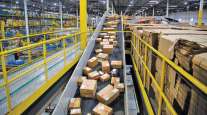Managing Editor, Features and Multimedia
How 3PLs Are Building More Collaborative Supply Chains
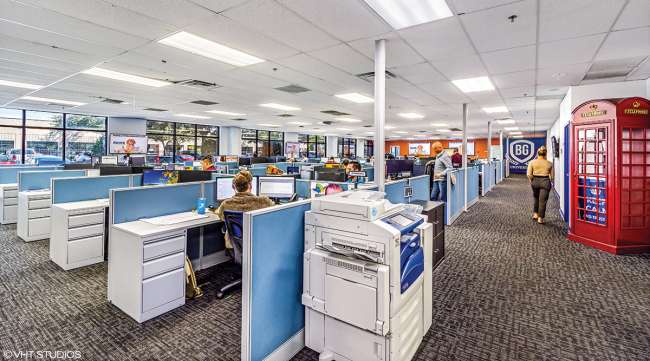
[Stay on top of transportation news: Get TTNews in your inbox.]
Third-party logistics providers have been adjusting to normalizing market conditions as the historic supply chain disruptions, inventory shortages and surging freight demand of the last few years have receded into the past.
But with the memory of those extraordinary times still fresh, 3PLs are now working to build more efficient and resilient supply chains for the future.
Logistics companies of all types, from freight brokers to warehousing and fulfillment providers, are pursuing closer collaboration with their shipper customers and carrier partners.
To realize that goal, logistics providers must get closer to their customers’ businesses to fully understand their needs and how their objectives interact with their supply chains, said BlueGrace Logistics CEO Bobby Harris.
“Going forward, I think you’ll see more and more of that collaboration happening, not just with the shipper, but with the carrier,” he said.
►2023 List Highlights Growth for 3PLs
►How 3PLs Are Building More Collaborative Supply Chains
►Map: Where the Top 100 Are
►Armstrong: A Year of Transition for 3PLs
►Shipment Visibility Is About Operational Excellence
►Sector Rankings Reflect Shifting Freight Market
Sector Rankings
Freight Brokerage | Dedicated
Dry Storage Warehousing
Refrigerated Warehousing
Ocean Freight | Airfreight
The value of true business partnerships among supply chain participants became especially clear amid the turbulence of the coronavirus pandemic and its many ripple effects on the flow of freight.
“Tough times for businesses mean they rely on their partners more than ever,” Harris said. “If you’re truly a partner — if you’re really, really there to make their business better — you will end up winning in the long run.”
By providing that level of customer support, 3PLs should be able to grow regardless of fluctuations in freight demand, Harris said, pointing to his own company as an example. BlueGrace, a freight brokerage and provider of managed transportation services, got its start in 2009 amid a particularly weak freight market.
Over the years, the role of 3PLs in the broader transportation industry has expanded. Harris said 3PLs are involved in a growing share of the total freight market, a trend he expects to continue in the years ahead.
“My belief is if you don’t have someone as a 3PL partner, whether it’s BlueGrace or one of my peers in the industry, I think you’re at a big disadvantage,” he said. “We always say we can help any business be better, and we really mean that. When we get in there, there’s some value we can provide.”
BlueGrace Logistics, based in Riverview, Fla., near Tampa, ranks No. 73 on the Transport Topics Top 100 list of the largest third-party logistics companies in North America.
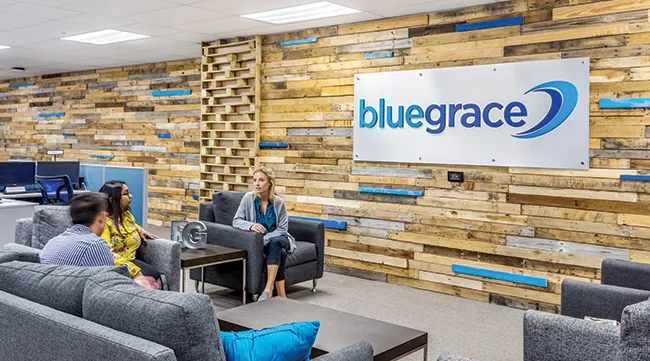
Logistics providers such as BlueGrace are emphasizing closer business partnerships with shippers and carriers alike to help drive greater supply chain efficiency. (BlueGrace Logistics)
The 3PLs that succeed in the future will be the ones that find a market niche and help their customers simplify their logistics challenges, said Nicole Glenn, founder and CEO of Candor Expedite, a brokerage specializing in expedited freight.
When she started the Plano, Texas-based company in 2017, she set out to support clients through a consultative approach to logistics — “to listen to what they have going on and then develop a strategy for them.”
Glenn expects that mergers and acquisitions will continue to reshape the third-party logistics space, with a widening gap between the industry’s numerous small firms and the very large companies that will expand through acquisition.
As supply chain disruptions have abated and truck capacity has loosened, negotiating power in the freight market has shifted from carriers back to the shippers.
At the same time, shippers have been reevaluating their transportation networks, which they expanded out of necessity to get through the pandemic, said Grant Goodale, co-founder and carrier experience officer at technology-enabled freight broker Convoy.
In some cases, that means partnering with a smaller number of freight transportation providers to optimize their networks moving forward, he said.
Meanwhile, some freight brokers are finding more ways to support their carriers, who have been facing tougher business conditions as freight demand has cooled.
Goodale said part of Convoy’s mission has always been to help carriers earn more with less hassle, starting with helping them maximize loaded miles and minimize deadhead between jobs.
Convoy recently introduced instant bid responses in its carrier app, enabling carriers to see if they won a bid right away rather than possibly waiting for hours while another potential job is available.
“They know immediately whether they’ve got it, they don’t, or if there’s a counteroffer on the table,” Goodale said.
Seattle-based Convoy ranks No. 54 on the TT100 list of logistics companies.
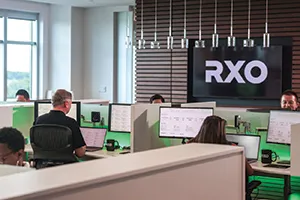
Freight brokers such as RXO are investing in technology to streamline processes, gain a competitive edge and improve efficiency for their shipper customers and carrier partners. (RXO)
Another freight broker taking steps to promote carrier loyalty is RXO, which spun off from less-than-truckload carrier XPO in November 2022.
Earlier this year, RXO announced a program to provide rewards and cost savings to its carriers. The program, RXO Extra, offers carriers savings on fuel, maintenance, tires, retail and more through an online marketplace.
“Obviously carriers are critical for us as a broker,” said Alyssa Myers, RXO’s vice president of brokerage technology. “Investing in that carrier relationship across the board is absolutely critical for us to effectively serve our customers.”
RXO, based in Charlotte, N.C., ranks No. 18 on the TT100 list of logistics companies.
Shifting Market Conditions
Many shippers did very well during the economic rebound from the pandemic, “but they’ll also lament some of their supply chain costs or lack of inventory” that prevented them from prospering even more, BlueGrace’s Harris said.
At that time, shippers were focused on securing whatever inventory they could get in a high demand environment, he said, but during the past year the prevailing sentiment has been more muted as markets have been normalizing and truck capacity has loosened.
Nonetheless, Harris expressed optimism that the freight market will improve in the second half of this year.
Many of BlueGrace’s largest customers are seeing their inventories begin to diminish again, and there will come a time when they need to restock.
“The American consumer still has a good amount of money pent up,” Harris said. “We don’t see that stopping. We see inventories depleting that need to be restocked, so the consensus is the second half of the year should be a little bit more fulfilling than the first half.”
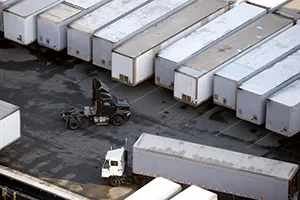
Trailers sit lined up in a yard. (kevinjeon00/Getty Images)
Despite a generally gloomy economic outlook heading into 2023, Mark Manduca, chief investment officer at GXO Logistics, characterized the economic environment as a “mixed bag” for consumer spending.
“There are shades of optimism out there,” he said, adding that fuel prices have abated from recent highs and interest rate increases have not been as severe as they might have been.
“I’m certainly not shouting from the hilltops that the macro is all sunny, but I see pockets of strength and overall I’m relatively bullish on 2023 for the consumer,” he said.
GXO, a contract logistics provider that split from XPO in 2021, ranks No. 6 on the TT100 list of logistics providers.
Technology Adoption
A core element of the push for a more collaborative supply chain is the technology needed to enable it.
BlueGrace’s Harris said technology can help bring supply chain partners together through connectivity and constant data flows that can improve decision making as conditions change.
“Businesses’ needs are constantly changing, not month to month, or week to week, but sometimes hour to hour … and technology is bringing us a lot closer,” he said.
Modern freight brokers must become tech-enabled or risk being left behind.
“It’s table stakes now,” Harris said. “You will see more and more consolidation happen in this industry in the next few years, and the ones that will get gobbled up — or won’t even make it — are the ones that didn’t stay with the times and didn’t take the layups when it comes to technology.”
Even as the transportation industry has become more and more digital, there is still much room for improvement by using data to better match the needs of shippers and carriers.
“There’s so much waste still there for us to extricate — tremendous amounts,” Harris said.
Artificial intelligence, for example, holds great promise for enhancing data analytics and taking business planning to the next level, but technology alone is not the solution to all logistics challenges, he said.
“Today and 10 years from now, you’re still going to need humans having faith in each other, working with each other to get the absolute most optimum results from this powerful technology that we’re all discussing,” Harris said.
Tech-enabled freight brokerage also is at the heart of RXO’s strategy.
Businesses’ needs are constantly changing, not month to month, or week to week, but sometimes hour to hour … and technology is bringing us a lot closer.
Bobby Harris, BlueGrace Logistics
Image
RXO’s Myers said technology is “part of our DNA” as a spinoff of XPO, which invested heavily in technology while expanding its operations during the past decade.
“We’re going to continue to double down on those investments,” Myers said. “One of the edges I think we have is the fact that we’ve married the operations and the technology from the start, and they’ve really continued to feed upon each other and fuel our growth.”
She identified the application of AI and machine learning and better utilization of data as key technology trends shaping the future of logistics.
“I really think that’s going to continue to be what drives technology in the industry forward,” Myers said.
Industry collaboration also is taking hold in the freight technology space.
Late last year, rivals Convoy, Uber Freight and J.B. Hunt Transport came together to form a consortium working to establish an application programming interface standard to simplify freight scheduling.
“We think there’s real opportunity for a royalty-free standard to have massive impact around efficiency in the industry,” Convoy’s Goodale said.
Much of the manual labor at a brokerage is connected to scheduling, which can involve email and web portals attached to disparate transportation management and warehouse management systems with no unified interface, he said.
“It’s incredibly fragmented and highly manual,” Goodale added. “If there are things we can do to make integrating software easier so that building great tools on top of it is faster, we all win.”
Automated Warehousing
Contract logistics providers also are increasingly embracing technology to complement their workforces and keep pace with the stringent demands of e-commerce fulfillment.
Warehouse operators have been facing labor shortages and wage pressures while at the same time working to support customers by increasing throughput and reducing the time from click to delivery, said Drew Bailey, vice president of design engineering at Geodis.
To help address those challenges, contract logistics providers have been deploying robots to transport goods inside the warehouse or automatically pick products to be shipped.
“Automation is becoming a cost of doing business,” Bailey said.
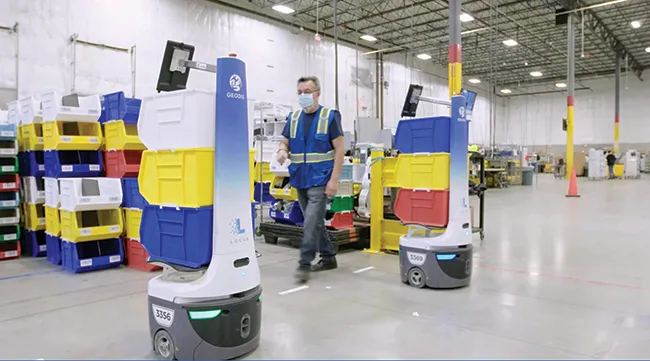
Warehouse robots from Locus Robotics transport goods inside a Geodis facility in Kutztown, Pa. Contract logistics providers are increasingly turning to automation to help speed up fulfillment. (Geodis)
Industrywide adoption of this technology is still in the early stages, with the majority of distribution and fulfillment centers still having little to no mechanization, he said.
That is poised to change, however, as technology developers and investors aim to realize the full potential of warehouse automation.
Rather than eliminating jobs, Bailey sees automation as a way to increase velocity inside the four walls and alleviate the need to ramp up hiring during demand peaks.
Instead, automation can make warehouse jobs better, not only through improving safety and reducing strain and fatigue, but also through the cognitive benefits of working with technology, he said.
“It doesn’t matter who you are, whether you’re a software developer or an engineer or a picker. Everybody likes to work with neat stuff,” Bailey said. “It makes it more enjoyable. It makes you feel like you’re doing something more substantial.”
Geodis ranks No. 27 on the TT Top 100 Logistics Companies list.
Automation also can create a more compelling case for shippers to outsource fulfillment to contract logistics providers.
By moving their products through automated warehouses, shippers can better weather fluctuations in the economy, GXO’s Manduca said.
While it’s easy to assume that automation has been widely deployed in warehouses across the globe, the industry is still barely 5% automated, he said, adding that a small group of very large contract logistics providers are leading the way on this front.
Today, GXO’s warehouses are roughly a third automated, Manduca said. “We’re trying to get to 40% by 2027, and some of the contracts that we’re signing today are 50-70% automated.”
Flexible Fulfillment
Meanwhile, the coronavirus pandemic has altered traditional notions of business-to-consumer and business-to-business fulfillment and shipping, said Steve Denton, CEO of Ware2Go, a UPS-owned warehousing and fulfillment company.
Employees who have been working remotely now want business packages delivered to their homes, for example.
Today, customers are seeking not only speedy delivery, but also more certainty about how and when products are delivered, Denton said.
I’m certainly not shouting from the hilltops that the macro is all sunny, but I see pockets of strength and overall I’m relatively bullish on 2023 for the consumer.
Mark Manduca, GXO
Image
“Going into the pandemic, everyone wanted this Amazon-like 2-day delivery experience, and certainly that has not gone away, but I would tell you right now, certainty is equally important as speed,” he said. “More and more consumers are OK with three days, as long as they know it’s three days.”
Consumers also are demanding more flexible delivery options.
Saturday delivery has become a “must have,” he said, and consumers increasingly want the option to buy a product online and pick it up in the store on the same day.
“Optionality with certainty,” Denton said. “We’re having more conversations about that today than just speed.”
Flexibility is important not only for consumers, but also for merchants as they face challenges such as rising warehouse rent, low shelf vacancy and a tight labor market.
Ware2Go, which began at an innovation lab at UPS and was incorporated in 2018, offers an asset-light fulfillment network through warehouses across the country connected on a common technology platform.
This model gives shippers the flexibility to pay for space and labor when they need it rather than building their own warehouses or signing long-term contracts, Denton said.
“As a merchant, you’re not paying a $100,000 implementation fee. You’re not signing a 5-year 3PL deal. You’re not committing to monthly minimums,” he said. “You’re paying a pretty light technology setup fee and then you’re paying for what you use. You pay for the storage you use, you pay for the labor you use, you pay for the shipping you use. It’s all like an Uber model or an Airbnb model.”
Environmental Sustainability
A growing number of shippers are looking for opportunities to reduce carbon emissions in their supply chains as a way to achieve their environmental sustainability targets.
Harris of BlueGrace said third-party logistics providers have an important role to play in this movement to curb emissions in the freight transportation industry.
“The very core of a 3PL is to reduce waste, reduce unneeded shipments, consolidate shipments,” he said.
While some carriers have begun deploying battery-electric trucks with zero tailpipe emissions in certain applications, that technology will take many years to scale up and is not currently a good fit for many trucking operations.
Want more news? Listen to today's daily briefing above or go here for more info
Apart from cleaner trucks, Harris said there is still significant opportunity to improve freight efficiency through better planning, avoiding unnecessary shipments through load consolidation and utilizing less carbon intensive modes of transportation where it makes sense.
“Sometimes the answers are right in front of us,” he said. “We can reduce waste now in a lot of ways, and we are. I love seeing that shippers are more conscious of it. They are asking about it. They want to know how they can help, and how we can help them achieve their goals.”






